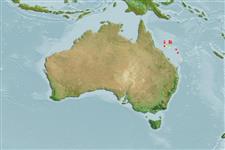Common names from other countries
Elasmobranquios (tiburones y rayas) (sharks and rays) >
Rajiformes (Skates and rays) >
Anacanthobatidae (Smooth skates)
Etymology: filicauda: Name from Latin ‘filum’ meaning thread and ‘cauda’ for tail or appendage, referring to its thread-like tail tip..
More on authors: Last & Séret.
Environment: milieu / climate zone / depth range / distribution range
Ecología
marino batidemersal; rango de profundidad 606 - 880 m (Ref. 75174). Tropical; 17°S - 25°S, 149°E - 156°E (Ref. 75174)
Western Pacific: (Queensland) Australia, possibly more widespread in Northern Coral Sea (Refs. 75174, 114953).
Tamaño / Peso / Age
Maturity: Lm ? range ? - ? cm
Max length : 55.0 cm TL macho / no sexado; (Ref. 75174)
Short description
Claves de identificación | Morfología | Morfometría
This species is distinguished by the following set of characters:: disc large, width at anterior orbit 5.7-8.1 times mouth width; tail short, postcloacal length 97-140% of disc length; eyes relatively large, orbit diameter 7.1-9.6 in horizontal snout and 9.4-11.3 in head lengths respectively; distal portion of tail not expanded, width of tail near tip 0.7-1.1 times tail width at its midlength; pectoral-fin radials 71-75; pelvic fins moderate-sized, anterior lobe 14.8-16.2% TL; anterior pelvic-fin lobe rather broad-based, width 1.6-2.5 in distance between pelvic-fin origins; caudal fin rudimentary; tooth rows in each jaw of adults 18-22; teeth of adult males with very short cusps; monospondylous vertebral centra 27-30, total centra 155-182; dorsal surface uniformly pale pinkish brown, ventral surface pale, translucent (Ref. 75174).
Life cycle and mating behavior
Maturities | Reproducción | Spawnings | Egg(s) | Fecundities | Larva
Last, P.R. and B. Séret, 2008. Three new legskates of the genus Sinobatis (Rajoidei: Anacanthobatidae) from the Indo-West Pacific. Zootaxa 1671:33-58. (Ref. 75174)
IUCN Red List Status (Ref. 130435)
CITES (Ref. 128078)
Not Evaluated
Threat to humans
Harmless
Human uses
Herramientas
Special reports
Download XML
Fuentes de Internet
Estimates based on models
Preferred temperature (Ref.
115969): 5.5 - 8.2, mean 6.3 (based on 7 cells).
Phylogenetic diversity index (Ref.
82804): PD
50 = 0.5020 [Uniqueness, from 0.5 = low to 2.0 = high].
Bayesian length-weight: a=0.01000 (0.00244 - 0.04107), b=3.04 (2.81 - 3.27), in cm Total Length, based on all LWR estimates for this body shape (Ref.
93245).
Nivel trófico (Ref.
69278): 3.8 ±0.6 se; based on size and trophs of closest relatives
Fishing Vulnerability (Ref.
59153): Moderate vulnerability (42 of 100).
